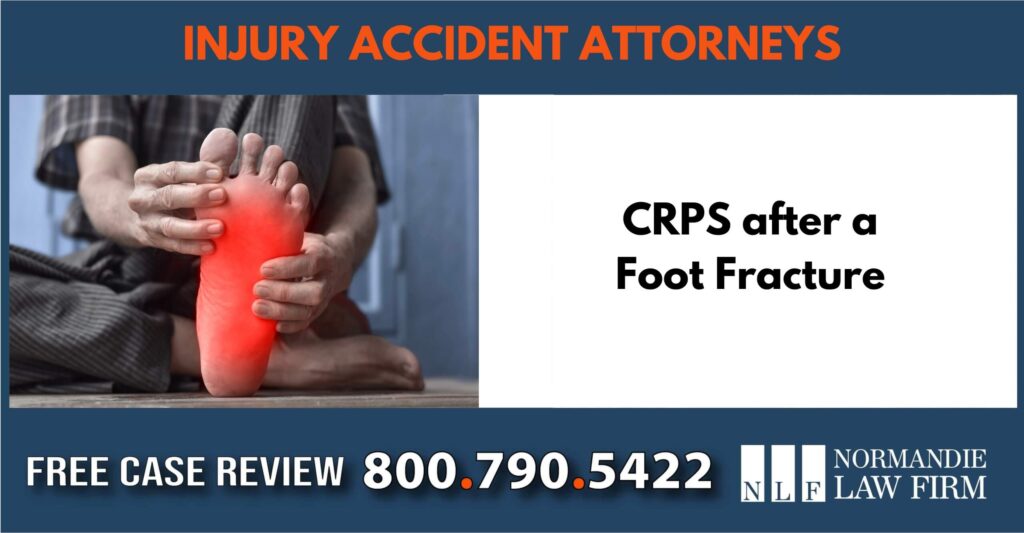CRPS, or complex regional pain syndrome is a largely misunderstood health condition that can happen after a traumatic injury. A foot fracture, where one or more bones in the feet are broken, can lead to CRPS and all its debilitating complications. The chronic pain and discomfort of CPRS may be triggered by an accident, like a slip and fall or car crash. A workplace injury can also be the cause of complex regional pain syndrome.
Learning about the causes and symptoms of CRPS and the legal implications of being harmed by another party are crucial to obtaining fair compensation after a fracture to your foot.
About Complex Regional Pain Syndrome (CRPS)
CRPS is a condition that causes chronic pain, along with other symptoms in one or more limbs, meaning that the effect is in your arm, leg, hand, or foot. The pain occurs after an injury has fully healed, and the level of pain is disproportionate to the initial injury. So, the scans may show that the fracture is completely resolved, yet you are continuing to have intense pain, swelling, hypersensitive, etc. that is constant or comes and goes.
Patients are diagnosed with one of two types of CRPS:
- CRPS-I – formerly known as RSD (reflex sympathetic dystrophy), this category of CRPS does not involve a nerve injury.
- CRPS-II – once known as causalgia, this condition occurs when there is damage to a specific nerve.
Not everyone who has fractured their foot will develop complex regional pain syndrome. But even minor traumas, like twisting an ankle from slipping on the floor, can trigger CRPS I or II.

Our Recent Verdicts and Settlements
$2.5 Million
$1.1 Million
$1.5 Million
$600,000
$525,000
$734,851
Common Causes of CRPS
People can develop chronic pain after an injury to the foot, like a fractured metatarsal. Such injuries are commonly associated with the following events:
- Car accidents – crashes and other high impact incidents can easily cause fractures that progress into some form of chronic pain.
- Fall accidents – slip and fall or trip and fall accidents often cause fractures and dislocations that lead to CRPS.
- Falling object on foot – something falling on your foot can result in breakage of one or more bones.
- Work injuries – blunt force trauma or repetitive tasks over months or years can evolve into complex regional pain syndrome.
- Surgical procedures – the procedure to repair a bone fracture or damaged ligament can sometimes trigger CRPS.
Abnormal interactions between the nervous systems (peripheral and central) are believed to be the underlying mechanism that leads to changes in blood flow, inflammation, and pain response.
Symptoms of Chronic Regional Pain Syndrome
Symptoms of CRPS will vary for each patient in terms of duration and intensity. Indicators of CRPS generally include:
- Burning or throbbing pain that is disproportionate to the severity of injury
- Extreme sensitivity to being touched, even from stimuli that should not be painful like air movement
- Loss of function / mobility
- Unusual swelling and stiffness in the area that’s affected by CPRS
- Skin temperature and color changes (skin is more pale, blue, or reddish, for example)
- Tremors and muscle weakness that leads to atrophy
- Abnormal nail or hair growth in affected limb / region
For many patients, CPRS will progress in various stages, meaning it can start with swelling and sharp pain and advance to changes in skin color and texture. If left untreated, complex regional pain syndrome can cause disability where mobility and function in the limb is permanently reduced.
How Doctors Diagnose CRPS
Complex regional pain syndrome is a complex medical condition, and this is why a combination of tests and physical exams are required in order to rule out other conditions and officially diagnose someone with CRPS. Most doctors specializing in CRPS use the Budapest Criteria, which is based on:
- Pain disproportionate to the injury that does not go away
- Symptoms fall within at least 3 of the following categories: sensory, sudomotor/edema, vasomotor, and motor/trophic.
- Symptoms in 2 or more categories were observed during examination
- The symptoms cannot be explained any better by another diagnosis
Doctors also use diagnostic tools in the determination of CPRS, which may include:
- Bone scans (helps detect abnormal blood flow)
- MRI to rule out other conditions
- Checking for bone density changes via X-rays
How is CRPS Treated?
The treatment of complex regional pain syndrome involves multiple approaches, which will vary from one patient to another. Here are some of the methods to help you live with the effects of CRPS:
- Pain relievers such as neuropathic agents, antidepressants, and corticosteroids
- Occupational and physical therapy
- Synthetic nerve blocks
- Electrical impulse stimulation to the spinal cord
- Psychological counseling for depression and other mental health issues
- Acupuncture, mirror therapy and other kinds of alternative medicine
Keep in mind that treatments are on-going and may need to be modified over time, as CRPS is notoriously difficult to treat. Even with continued treatment, patients may end up with long-term or permanent impairments.
Your Right to Sue for CRPS after an Accident
When you develop CRPS after a foot fracture, you may have grounds to seek compensation through a personal injury claim. Because this is a complication related to an injury, it can be difficult to overcome objections by the insurance company and obtain damages from a lawsuit or workers’ comp claim. To proceed with a case, here are some issues to think about:
- Causation – you must show that the accident was the primary / substantial cause of CRPS, which required extensive medical records and testimony from medical experts.
- Your right to compensation (damages) – after developing CRPS from a foot injury, you may be entitled to monetary damages like medical expenses, lost income and earning capacity, pain and suffering, emotional distress, and property damage.
- Lifetime care needs – as CPRS is a chronic condition, you need to consider on-going care expenses in the calculation of a CRPS injury settlement.
- Comparative negligence – California law assigns a percentage of blame to all the parties involved in an accident. This can include some degree of fault by the injury victim and other individuals or entities (a business, product manufacturer, government agency, etc.). If you are partially responsible for the incident, you still have the right to sue, but your recovered damages will be reduced by your percentage of fault.
- Medical malpractice – it’s possible that careless or reckless conduct by a medical professional is the reason you ended up with chronic pain. Medical malpractice claims involve different procedures and timelines compared to the average lawsuit for personal injury. There is also a cap of $500,000 for non-economic damages if you are suing on the basis of negligence by a healthcare provider.
Legal Challenges Facing Injury Victims
Those who are interested in pursuing a claim for complex regional pain syndrome face multiple challenges:
- Insurance company disputes – it’s very common for insurance companies to argue that the claimant is exaggerating their symptoms, or that a diagnosis of CRPS is unrelated to the accident
- Proving the existence of CRPS – a fracture is visible on an X-ray, but CRPS is an invisible injury, so it can be difficult to prove that you have the condition.
- Long-term damages – insurance companies want to undercut your settlement as much as possible, so you may face arguments that your condition will improve over time.
- Expert testimony – expert opinions may be needed from physicians that specialize in pain management, orthopedics, and neurology.
Hypothetical Case for a Foot Fracture Resulting in CRPS Lawsuit
A woman in her 40s is at a grocery store when a heavy item placed on the edge of a high shelf falls on her foot. She fractures one of her metatarsal bones and needs surgery, followed by physical rehabilitation. In spite of all the required treatments, she continues to have pain that only gets worse over time. Eventually, the swelling, hypersensitivity, and other changes in her foot lead to a diagnosis of complex regional pain syndrome.
The woman is unable to return to her job as a nurse and suffers emotional distress due to on-going financial problems and losing her career. As part of her lawsuit, her lawyer presents medical records form numerous hospitals, testimony from her physician and therapist, and her immediate and projected loss of income. Thus, he establishes a clear basis of how the accident has impacted her life and why she is due a certain amount of compensation.
Statute of Limitations for a Personal Injury Lawsuit
All claims for injuries caused by negligence or misconduct must be filed within 2 years of the injury. This may be the point of sustaining a foot fracture, i.e., the accident date. But the laws in California also provide victims with 2 years to sue for a delayed discovery of injury. So, depending on when you are diagnosed with CRPS, you can choose to seek restitution within 2 years of the discovery date.
If your foot fracture is work-related, you have 1 year to file a workers’ compensation claim with your employer. Before you can file a claim, your employer must be notified of the accident on diagnosis of injury within 30 days. Make sure to consult an attorney in order to verify the correct deadline and preserve your right to demand compensation from the liable party.
Legal Representation after CRPS from a Foot Fracture
CRPS is a life-altering condition that can happen to anyone, even after a relatively minor injury. Those who live with this condition face considerable challenges in their daily lives, along with legal hurdles when they file an accident claim. With the right lawyer by your side, you can obtain payments to make up for monetary losses and diminished quality of life.
For advice and guidance from a personal injury law firm, contact our office immediately. We will advise you of your rights and how we can help you navigate the legal system, one step at a time. Our attorneys accept cases under the Zero Fee Guarantee, which is a contingency fee structure where you pay $0. Instead of asking you for legal fees, we wait until the release of your settlement check from the other side. If the case is not resolved in your favor, you owe us absolutely nothing.
For more information on suing for chronic pain after an injury to your foot, please schedule a free, private consultation with our legal team.











